Weijie Su
How to Find Fantastic Papers: Self-Rankings as a Powerful Predictor of Scientific Impact Beyond Peer Review
Oct 02, 2025Abstract:Peer review in academic research aims not only to ensure factual correctness but also to identify work of high scientific potential that can shape future research directions. This task is especially critical in fast-moving fields such as artificial intelligence (AI), yet it has become increasingly difficult given the rapid growth of submissions. In this paper, we investigate an underexplored measure for identifying high-impact research: authors' own rankings of their multiple submissions to the same AI conference. Grounded in game-theoretic reasoning, we hypothesize that self-rankings are informative because authors possess unique understanding of their work's conceptual depth and long-term promise. To test this hypothesis, we conducted a large-scale experiment at a leading AI conference, where 1,342 researchers self-ranked their 2,592 submissions by perceived quality. Tracking outcomes over more than a year, we found that papers ranked highest by their authors received twice as many citations as their lowest-ranked counterparts; self-rankings were especially effective at identifying highly cited papers (those with over 150 citations). Moreover, we showed that self-rankings outperformed peer review scores in predicting future citation counts. Our results remained robust after accounting for confounders such as preprint posting time and self-citations. Together, these findings demonstrate that authors' self-rankings provide a reliable and valuable complement to peer review for identifying and elevating high-impact research in AI.
InternVL3.5: Advancing Open-Source Multimodal Models in Versatility, Reasoning, and Efficiency
Aug 25, 2025Abstract:We introduce InternVL 3.5, a new family of open-source multimodal models that significantly advances versatility, reasoning capability, and inference efficiency along the InternVL series. A key innovation is the Cascade Reinforcement Learning (Cascade RL) framework, which enhances reasoning through a two-stage process: offline RL for stable convergence and online RL for refined alignment. This coarse-to-fine training strategy leads to substantial improvements on downstream reasoning tasks, e.g., MMMU and MathVista. To optimize efficiency, we propose a Visual Resolution Router (ViR) that dynamically adjusts the resolution of visual tokens without compromising performance. Coupled with ViR, our Decoupled Vision-Language Deployment (DvD) strategy separates the vision encoder and language model across different GPUs, effectively balancing computational load. These contributions collectively enable InternVL3.5 to achieve up to a +16.0\% gain in overall reasoning performance and a 4.05$\times$ inference speedup compared to its predecessor, i.e., InternVL3. In addition, InternVL3.5 supports novel capabilities such as GUI interaction and embodied agency. Notably, our largest model, i.e., InternVL3.5-241B-A28B, attains state-of-the-art results among open-source MLLMs across general multimodal, reasoning, text, and agentic tasks -- narrowing the performance gap with leading commercial models like GPT-5. All models and code are publicly released.
CoMemo: LVLMs Need Image Context with Image Memory
Jun 06, 2025


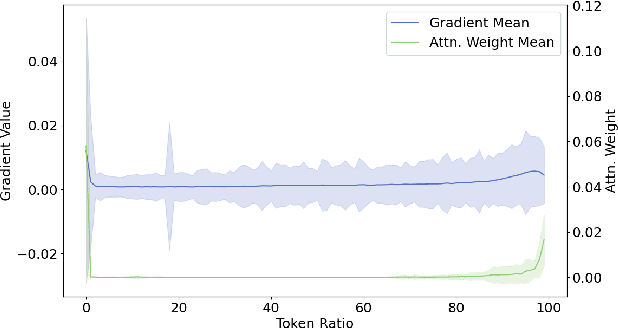
Abstract:Recent advancements in Large Vision-Language Models built upon Large Language Models have established aligning visual features with LLM representations as the dominant paradigm. However, inherited LLM architectural designs introduce suboptimal characteristics for multimodal processing. First, LVLMs exhibit a bimodal distribution in attention allocation, leading to the progressive neglect of middle visual content as context expands. Second, conventional positional encoding schemes fail to preserve vital 2D structural relationships when processing dynamic high-resolution images. To address these limitations, we propose CoMemo - a dual-path architecture that combines a Context image path with an image Memory path for visual processing, effectively alleviating visual information neglect. Additionally, we introduce RoPE-DHR, a novel positional encoding mechanism that employs thumbnail-based positional aggregation to maintain 2D spatial awareness while mitigating remote decay in extended sequences. Evaluations across seven benchmarks,including long-context comprehension, multi-image reasoning, and visual question answering, demonstrate CoMemo's superior performance compared to conventional LVLM architectures. Project page is available at https://lalbj.github.io/projects/CoMemo/.
ZeroGUI: Automating Online GUI Learning at Zero Human Cost
May 29, 2025Abstract:The rapid advancement of large Vision-Language Models (VLMs) has propelled the development of pure-vision-based GUI Agents, capable of perceiving and operating Graphical User Interfaces (GUI) to autonomously fulfill user instructions. However, existing approaches usually adopt an offline learning framework, which faces two core limitations: (1) heavy reliance on high-quality manual annotations for element grounding and action supervision, and (2) limited adaptability to dynamic and interactive environments. To address these limitations, we propose ZeroGUI, a scalable, online learning framework for automating GUI Agent training at Zero human cost. Specifically, ZeroGUI integrates (i) VLM-based automatic task generation to produce diverse training goals from the current environment state, (ii) VLM-based automatic reward estimation to assess task success without hand-crafted evaluation functions, and (iii) two-stage online reinforcement learning to continuously interact with and learn from GUI environments. Experiments on two advanced GUI Agents (UI-TARS and Aguvis) demonstrate that ZeroGUI significantly boosts performance across OSWorld and AndroidLab environments. The code is available at https://github.com/OpenGVLab/ZeroGUI.
PolarGrad: A Class of Matrix-Gradient Optimizers from a Unifying Preconditioning Perspective
May 27, 2025Abstract:The ever-growing scale of deep learning models and datasets underscores the critical importance of efficient optimization methods. While preconditioned gradient methods such as Adam and AdamW are the de facto optimizers for training neural networks and large language models, structure-aware preconditioned optimizers like Shampoo and Muon, which utilize the matrix structure of gradients, have demonstrated promising evidence of faster convergence. In this paper, we introduce a unifying framework for analyzing "matrix-aware" preconditioned methods, which not only sheds light on the effectiveness of Muon and related optimizers but also leads to a class of new structure-aware preconditioned methods. A key contribution of this framework is its precise distinction between preconditioning strategies that treat neural network weights as vectors (addressing curvature anisotropy) versus those that consider their matrix structure (addressing gradient anisotropy). This perspective provides new insights into several empirical phenomena in language model pre-training, including Adam's training instabilities, Muon's accelerated convergence, and the necessity of learning rate warmup for Adam. Building upon this framework, we introduce PolarGrad, a new class of preconditioned optimization methods based on the polar decomposition of matrix-valued gradients. As a special instance, PolarGrad includes Muon with updates scaled by the nuclear norm of the gradients. We provide numerical implementations of these methods, leveraging efficient numerical polar decomposition algorithms for enhanced convergence. Our extensive evaluations across diverse matrix optimization problems and language model pre-training tasks demonstrate that PolarGrad outperforms both Adam and Muon.
Do Large Language Models (Really) Need Statistical Foundations?
May 25, 2025Abstract:Large language models (LLMs) represent a new paradigm for processing unstructured data, with applications across an unprecedented range of domains. In this paper, we address, through two arguments, whether the development and application of LLMs would genuinely benefit from foundational contributions from the statistics discipline. First, we argue affirmatively, beginning with the observation that LLMs are inherently statistical models due to their profound data dependency and stochastic generation processes, where statistical insights are naturally essential for handling variability and uncertainty. Second, we argue that the persistent black-box nature of LLMs -- stemming from their immense scale, architectural complexity, and development practices often prioritizing empirical performance over theoretical interpretability -- renders closed-form or purely mechanistic analyses generally intractable, thereby necessitating statistical approaches due to their flexibility and often demonstrated effectiveness. To substantiate these arguments, the paper outlines several research areas -- including alignment, watermarking, uncertainty quantification, evaluation, and data mixture optimization -- where statistical methodologies are critically needed and are already beginning to make valuable contributions. We conclude with a discussion suggesting that statistical research concerning LLMs will likely form a diverse ``mosaic'' of specialized topics rather than deriving from a single unifying theory, and highlighting the importance of timely engagement by our statistics community in LLM research.
A RAG-Based Multi-Agent LLM System for Natural Hazard Resilience and Adaptation
Apr 24, 2025Abstract:Large language models (LLMs) are a transformational capability at the frontier of artificial intelligence and machine learning that can support decision-makers in addressing pressing societal challenges such as extreme natural hazard events. As generalized models, LLMs often struggle to provide context-specific information, particularly in areas requiring specialized knowledge. In this work we propose a retrieval-augmented generation (RAG)-based multi-agent LLM system to support analysis and decision-making in the context of natural hazards and extreme weather events. As a proof of concept, we present WildfireGPT, a specialized system focused on wildfire hazards. The architecture employs a user-centered, multi-agent design to deliver tailored risk insights across diverse stakeholder groups. By integrating natural hazard and extreme weather projection data, observational datasets, and scientific literature through an RAG framework, the system ensures both the accuracy and contextual relevance of the information it provides. Evaluation across ten expert-led case studies demonstrates that WildfireGPT significantly outperforms existing LLM-based solutions for decision support.
InternVL3: Exploring Advanced Training and Test-Time Recipes for Open-Source Multimodal Models
Apr 15, 2025Abstract:We introduce InternVL3, a significant advancement in the InternVL series featuring a native multimodal pre-training paradigm. Rather than adapting a text-only large language model (LLM) into a multimodal large language model (MLLM) that supports visual inputs, InternVL3 jointly acquires multimodal and linguistic capabilities from both diverse multimodal data and pure-text corpora during a single pre-training stage. This unified training paradigm effectively addresses the complexities and alignment challenges commonly encountered in conventional post-hoc training pipelines for MLLMs. To further improve performance and scalability, InternVL3 incorporates variable visual position encoding (V2PE) to support extended multimodal contexts, employs advanced post-training techniques such as supervised fine-tuning (SFT) and mixed preference optimization (MPO), and adopts test-time scaling strategies alongside an optimized training infrastructure. Extensive empirical evaluations demonstrate that InternVL3 delivers superior performance across a wide range of multi-modal tasks. In particular, InternVL3-78B achieves a score of 72.2 on the MMMU benchmark, setting a new state-of-the-art among open-source MLLMs. Its capabilities remain highly competitive with leading proprietary models, including ChatGPT-4o, Claude 3.5 Sonnet, and Gemini 2.5 Pro, while also maintaining strong pure-language proficiency. In pursuit of open-science principles, we will publicly release both the training data and model weights to foster further research and development in next-generation MLLMs.
PVC: Progressive Visual Token Compression for Unified Image and Video Processing in Large Vision-Language Models
Dec 12, 2024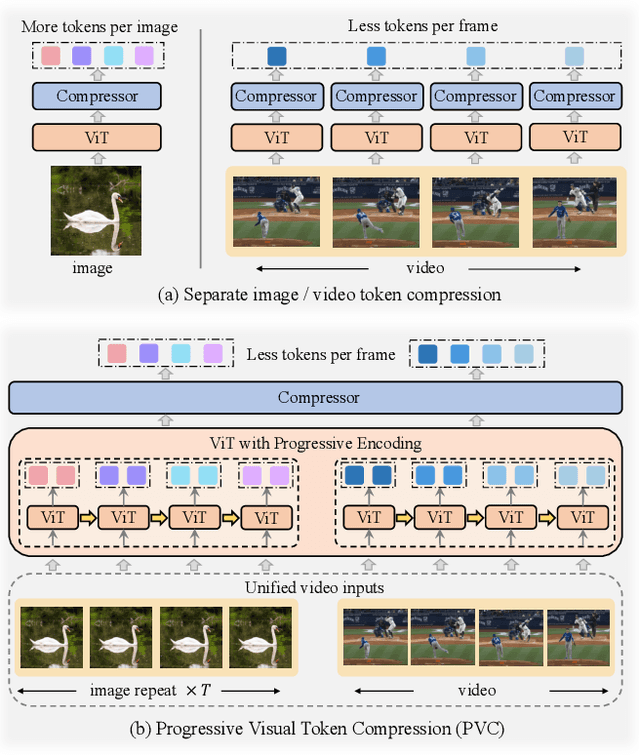
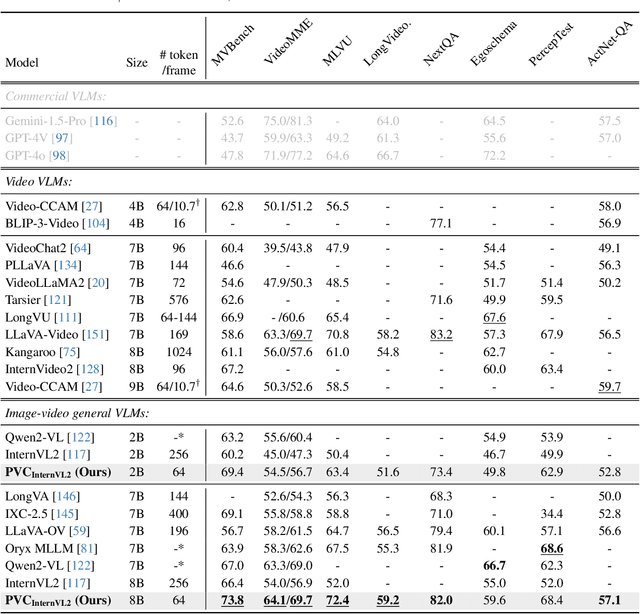
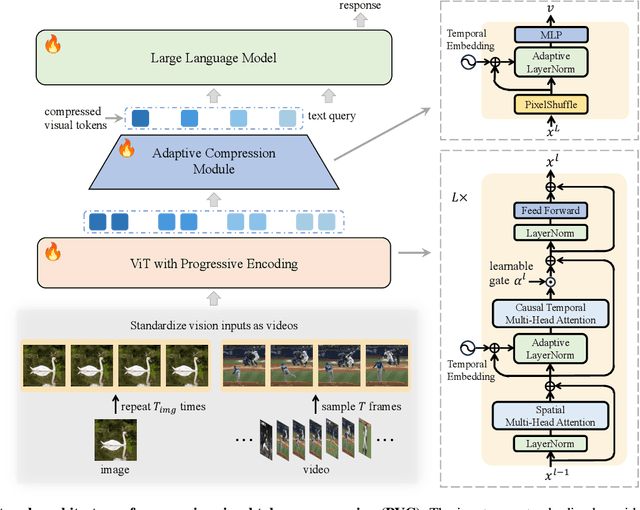
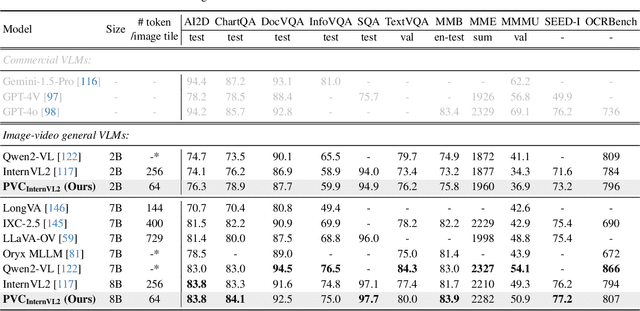
Abstract:Large Vision-Language Models (VLMs) have been extended to understand both images and videos. Visual token compression is leveraged to reduce the considerable token length of visual inputs. To meet the needs of different tasks, existing high-performance models usually process images and videos separately with different token compression strategies, limiting the capabilities of combining images and videos. To this end, we extend each image into a "static" video and introduce a unified token compression strategy called Progressive Visual Token Compression (PVC), where the tokens of each frame are progressively encoded and adaptively compressed to supplement the information not extracted from previous frames. Video tokens are efficiently compressed with exploiting the inherent temporal redundancy. Images are repeated as static videos, and the spatial details can be gradually supplemented in multiple frames. PVC unifies the token compressing of images and videos. With a limited number of tokens per frame (64 tokens by default), spatial details and temporal changes can still be preserved. Experiments show that our model achieves state-of-the-art performance across various video understanding benchmarks, including long video tasks and fine-grained short video tasks. Meanwhile, our unified token compression strategy incurs no performance loss on image benchmarks, particularly in detail-sensitive tasks.
Fine-Tuning Linear Layers Only Is a Simple yet Effective Way for Task Arithmetic
Jul 09, 2024Abstract:Task arithmetic has recently emerged as a cost-effective and scalable approach to edit pre-trained models directly in weight space, by adding the fine-tuned weights of different tasks. The performance has been further improved by a linear property which is illustrated by weight disentanglement. Yet, conventional linearization methods (e.g., NTK linearization) not only double the time and training cost but also have a disadvantage on single-task performance. We propose a simple yet effective and efficient method that only fine-tunes linear layers, which improves weight disentanglement and efficiency simultaneously. Specifically, our study reveals that only fine-tuning the linear layers in the attention modules makes the whole model occur in a linear regime, significantly improving weight disentanglement. To further understand how our method improves the disentanglement of task arithmetic, we present a comprehensive study of task arithmetic by differentiating the role of representation model and task-specific model. In particular, we find that the representation model plays an important role in improving weight disentanglement whereas the task-specific models such as the classification heads can degenerate the weight disentanglement performance. Overall, our work uncovers novel insights into the fundamental mechanisms of task arithmetic and offers a more reliable and effective approach to editing pre-trained models.
 Add to Chrome
Add to Chrome Add to Firefox
Add to Firefox Add to Edge
Add to Edge